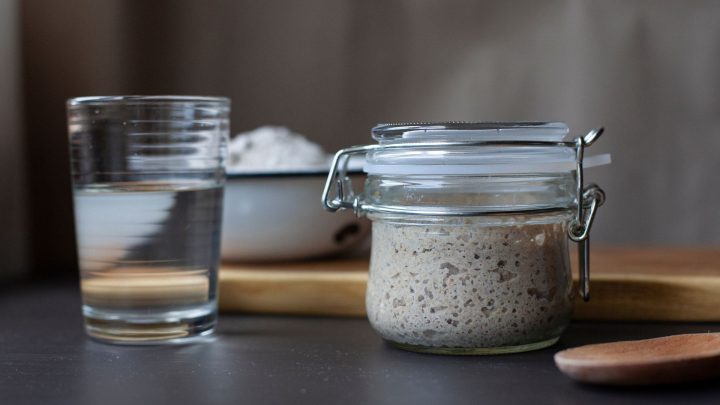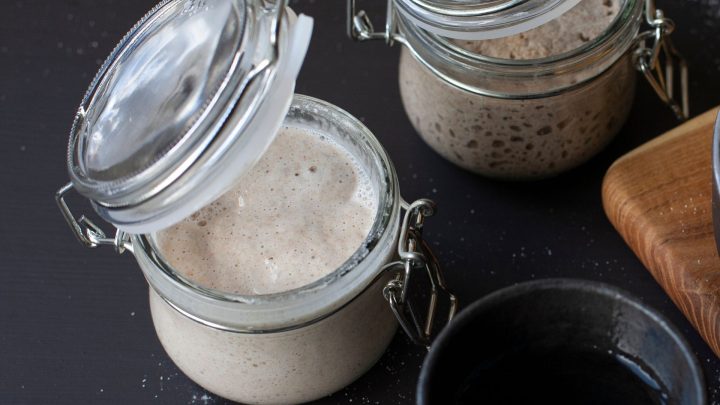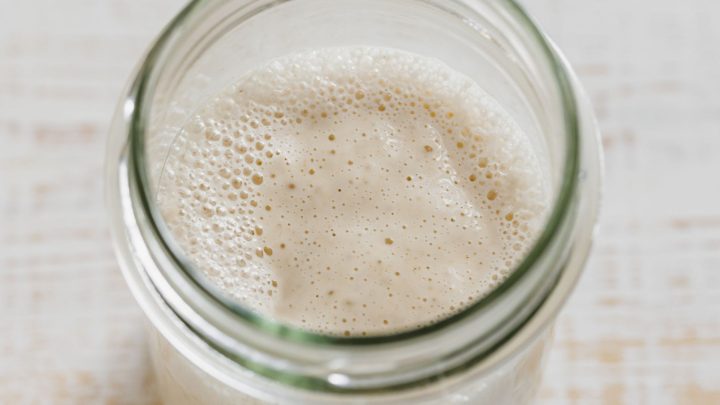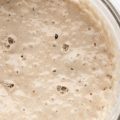Sourdough starters, the living cultures of wild yeast and bacteria used to leaven sourdough bread, are known for their incredible resilience and versatility. However, at times, you may encounter a common challenge: separation. When a sourdough starter separates, with a layer of liquid (known as hooch) forming on top, it can be a cause for concern. Understanding why this separation occurs and how to address it is crucial to maintain a healthy and active sourdough starter.

Table of Contents
- What Should a Sourdough Starter Look Like?
- Why is My Sourdough Starter Separating?
- Should I Stir My Sourdough Starter Between Feedings
- What to Do If Your Sourdough Starter Separates?
- My Sourdough Starter Has Hooch But Isn’t Rising
- How To Prevent Your Starter From Separating in The Future
- Can I Switch Flours For My Sourdough Starter?
- Sourdough Starter Separating
- FAQs
What Should a Sourdough Starter Look Like?
Sourdough starters can have different appearances depending on their specific characteristics, feeding schedule, and environmental factors.
However, here are some general observations about the appearance of a well-maintained and healthy starter:
- Bubbly and frothy: A healthy sourdough starter will typically exhibit a bubbly and frothy texture. After feeding, you should see a network of small to large bubbles throughout the mixture. These bubbles indicate that the yeast and bacteria in the starter are actively fermenting and producing carbon dioxide.
- Expanded volume: When you feed your starter, it should increase in volume and expand. It might even double or triple in size before gradually deflating. This rise and fall cycle signifies that the yeast in the starter is active and capable of leavening bread dough.
- Elastic and stretchy texture: A well-developed and mature starter will have a slightly elastic and stretchy texture.
Why is My Sourdough Starter Separating?
If your sourdough starter is separating, with a layer of liquid forming on top, it is a common phenomenon and typically not a cause for major concern. Here are a few reasons why separation occurs and what you can do about it:
- Hooch: A layer of liquid atop your sourdough starter is a natural byproduct of fermentation, consisting of alcohol and acetic acid. Hooch is a common indicator that your sourdough starter is active and going through fermentation. However, lots of hooch will indicate that your starter is hungry and requires a feed.
- Irregular feeding: Inconsistent feedings may contribute to the separation of your sourdough starter. When the starter is hungry, the yeast activity slows down.
- High hydration level: If your sourdough starter has a high hydration level (meaning it contains a higher ratio of water to flour), separation is more likely to occur. Higher hydration starters tend to have a looser consistency, which can lead to the separation of liquid.
- Ambient temperature and humidity: Environmental factors such as temperature and humidity can affect the activity and behavior of your sourdough starter. Warmer temperatures and higher humidity levels can accelerate fermentation and lead to increased hooch formation.

Should I Stir My Sourdough Starter Between Feedings
It is not necessary to stir your sourdough starter between feedings.
Stirring between feedings may introduce excess air into the starter, which can lead to oxidation and affect the balance of organisms in the starter.
Instead, it is recommended to leave your sourdough starter undisturbed between feedings, allowing the fermentation process to take place. The naturally occurring yeast and bacteria in the starter will work on the fresh flour and water, and stirring is not required during this period.
However, if your sourdough starter has separated, with a layer of liquid (hooch) on top, you can gently stir the hooch back into the starter before feeding or pouring it off if desired. This step helps maintain a consistent hydration level and distribute any accumulated alcohol and acids.
What to Do If Your Sourdough Starter Separates?
If your sourdough starter separates, with a layer of liquid (hooch) on top, here’s what you can do to address the situation:
- Stir the hooch back into the starter: Gently stir the hooch back into the starter to reincorporate the liquid. This helps maintain a consistent hydration level and redistributes any accumulated alcohol and acids. Stirring also allows oxygen to reach the starter, which can benefit the fermentation process.
- Pour off excess hooch: If there is a significant amount of hooch or if your starter has a thin consistency, you may choose to pour off some of the excess liquid. Pouring off the hooch will reduce the overall hydration of the starter and help bring it to a more manageable consistency.
- Adjust the feeding schedule: Separation in a sourdough starter is often a sign of hunger, indicating that the starter has depleted its food supply. Consider adjusting your feeding schedule to ensure more regular feedings. This might mean increasing the frequency of feedings or adjusting the ratio of flour to water in each feeding to provide more nourishment to the starter.
- Increase feeding amounts: If your starter consistently separates, it may be an indication that it needs more food. Try increasing the amount of flour and water you use during feedings. For example, you can increase the feeding ratio to 1:1:1 (equal parts starter, flour, and water) or even use a higher ratio, such as 1:2:2 or 1:3:3. This provides the starter with more food to sustain fermentation and reduce the likelihood of separation.
- Check fermentation conditions: Ensure that your sourdough starter is kept in an appropriate environment for fermentation. Maintain a stable room temperature (ideally between 70-80°F or 21-27°C) and avoid extreme temperature fluctuations. Providing a warm and draught-free location can help encourage a healthy fermentation process.
My Sourdough Starter Has Hooch But Isn’t Rising
If your sourdough starter has developed hooch but isn’t rising, it may indicate that your starter needs some adjustments. Here are a few possible reasons and corresponding solutions:
- Feeding frequency: If your starter is not rising, it could be due to infrequent feedings. The hooch formation is a sign that your starter is hungry and has used up its food supply. Consider increasing the feedings, as this will ensure consistent nourishment for the yeast and bacteria.
- Feeding ratio: The ratio of flour to water in your feedings can also impact your starter’s activity. If the starter is too liquid or has a high hydration level, it may struggle to rise properly. Simply adjust the feeding ratio to create a stiffer consistency, by increasing the amount of flour or reducing the amount of water. Try to aim for a dough-like consistency, which makes the starter easier to work with, and provides a better structure for rising.
- Starter strength: If your starter is relatively young or weak, it may take longer to develop the strength needed for a good rise. The yeast and bacteria populations need time to establish and multiply. Continue to maintain the feeding routine, and gradually the starter should strengthen and become more active. This may take days or even a week, so it’s important to be patient!
- Temperature and environment: The fermentation process is influenced by temperature and environmental conditions. Cooler temperatures or inconsistent warmth can hinder the rise of your starter. Ensure that your starter is kept in a warm place, ideally somewhere between 70-80°F (21-27°C) to encourage yeast activity.
- Starter health: If your starter has been neglected or hasn’t been fed regularly, it may have weakened, leading to poor rise. Simply discard a portion of the starter, and continue feeding with fresh flour and water. This should provide a nutrient boost and help revitalize the starter’s activity.
How To Prevent Your Starter From Separating in The Future
To prevent your sourdough starter from separating in the future, you can take the following steps:
- Maintain a consistent feeding schedule: Establishing a regular feeding routine is crucial for keeping your starter healthy and active. Feed your starter at the same time every day or every 12 hours, depending on its activity level and ambient temperature. Consistent feedings provide a steady supply of food for the yeast and bacteria, reducing the likelihood of separation.
- Adjust the hydration level: The hydration level of your starter, which refers to the ratio of water to flour, can influence its behavior. If your starter consistently separates, you can try reducing the hydration level to make it thicker and more manageable.
- Use a higher flour-to-water ratio during feedings: Increasing the amount of flour relative to water in your feedings can help provide more structure and stability to the starter. You can experiment with different ratios to find the balance that works best for your starter. For example, you can increase the flour-to-water ratio to 1:1.5 or even 1:2 (starter:flour: water).
- Monitor fermentation conditions: Pay attention to the temperature and environment in which your starter is kept. Aim for a stable room temperature between 70-80°F (21-27°C) to promote consistent fermentation. Extreme temperature fluctuations or excessively cool environments can impact the starter’s activity and potentially lead to separation.
- Use smaller amounts of starter when feeding: If you consistently feed your starter with large amounts of fresh flour and water, it can contribute to separation. Consider using smaller amounts of starter when feeding. For example, if you typically feed with a 1:1:1 ratio, you can reduce it to 1:0.5:0.5 or even lower.
- Store your starter in the refrigerator: If you find it challenging to maintain a consistent feeding schedule, you can store your starter in the refrigerator. Cold temperatures slow down the fermentation process, reducing the frequency of feedings. However, keep in mind that you’ll need to feed your starter regularly to maintain its health, even if it’s in the refrigerator.
- Maintain starter hygiene: Regularly clean and refresh your storage container or jar to prevent any build-up or contamination that could affect your starter’s health. Use clean utensils and avoid cross-contamination with other ingredients or substances.

Can I Switch Flours For My Sourdough Starter?
Yes, you can switch flours for your sourdough starter. Sourdough starters are generally adaptable and can be fed with different types of flours. Switching flours can introduce new flavors and characteristics to your starter, depending on the type of flour you choose.
Sourdough Starter Separating
To prevent or address separation, maintaining a consistent feeding schedule, adjusting the hydration level, and providing optimal fermentation conditions are key. Regular feedings, with a proper ratio of flour to water, help sustain the yeast and bacteria and reduce the likelihood of separation.
Adjusting the feeding frequency, increasing the amount of flour, and monitoring the temperature and environment can contribute to a stable and thriving starter.
FAQs
How Do I Know If I Ruined My Sourdough Starter?
Some of the clear indicators that determine a ruined sourdough starter include bad smell, mold growth, no activity, discoloration, or separation.
What Should Sourdough Starter Look Like?
A healthy sourdough starter should have: lots of bubbles in the mixture, rise and fall after every feed, have an elastic texture, form a layer of hooch, and emit a pleasant aroma.
Why is My Sourdough Not Coming Together?
Some of the reasons your sourdough is not coming together can include insufficient hydration, inadequate gluten development, overhydration, insufficient fermentation, incorrect flour, improper kneading, or issues with your sourdough starter.




![How To Freeze Sourdough Starter [Top Tips For Success] 7 How to freeze sourdough starter [top tips for success]](https://www.mydailysourdoughbread.com/wp-content/uploads/2023/06/storing-starter-in-freezer-120x120.jpg)
![How To Keep Sourdough Starter Warm [Best Tips And Why You Need To] 8 How to keep sourdough starter warm [best tips]](https://www.mydailysourdoughbread.com/wp-content/uploads/2023/07/a-bubbly-starter-on-a-cooling-rack-120x120.jpg)
